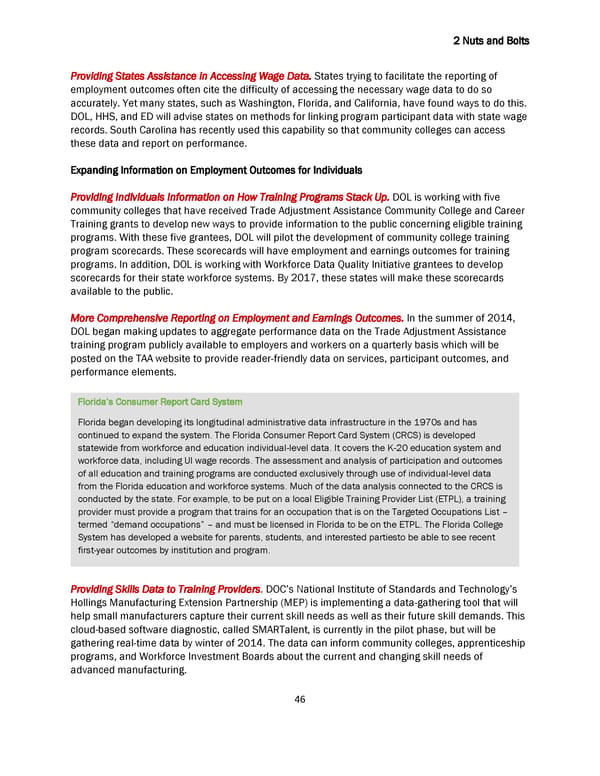2 Nuts and Bolts Providing States Assistance in Accessing Wage Data. States trying to facilitate the reporting of employment outcomes often cite the difficulty of accessing the necessary wage data to do so accurately. Yet many states, such as Washington, Florida, and California, have found ways to do this. DOL, HHS, and ED will advise states on methods for linking program participant data with state wage records. South Carolina has recently used this capability so that community colleges can access these data and report on performance. Expanding Information on Employment Outcomes for Individuals Providing Individuals Information on How Training Programs Stack Up. DOL is working with five community colleges that have received Trade Adjustment Assistance Community College and Career Training grants to develop new ways to provide information to the public concerning eligible training programs. With these five grantees, DOL will pilot the development of community college training program scorecards. These scorecards will have employment and earnings outcomes for training programs. In addition, DOL is working with Workforce Data Quality Initiative grantees to develop scorecards for their state workforce systems. By 2017, these states will make these scorecards available to the public. More Comprehensive Reporting on Employment and Earnings Outcomes. In the summer of 2014, DOL began making updates to aggregate performance data on the Trade Adjustment Assistance training program publicly available to employers and workers on a quarterly basis which will be posted on the TAA website to provide reader-friendly data on services, participant outcomes, and performance elements. Florida’s Consumer Report Card System Florida began developing its longitudinal administrative data infrastructure in the 1970s and has continued to expand the system. The Florida Consumer Report Card System (CRCS) is developed statewide from workforce and education individual-level data. It covers the K-20 education system and workforce data, including UI wage records. The assessment and analysis of participation and outcomes of all education and training programs are conducted exclusively through use of individual-level data from the Florida education and workforce systems. Much of the data analysis connected to the CRCS is conducted by the state. For example, to be put on a local Eligible Training Provider List (ETPL), a training provider must provide a program that trains for an occupation that is on the Targeted Occupations List – termed “demand occupations” – and must be licensed in Florida to be on the ETPL. The Florida College System has developed a website for parents, students, and interested partiesto be able to see recent first-year outcomes by institution and program. Providing Skills Data to Training Providers. DOC’s National Institute of Standards and Technology’s Hollings Manufacturing Extension Partnership (MEP) is implementing a data-gathering tool that will help small manufacturers capture their current skill needs as well as their future skill demands. This cloud-based software diagnostic, called SMARTalent, is currently in the pilot phase, but will be gathering real-time data by winter of 2014. The data can inform community colleges, apprenticeship programs, and Workforce Investment Boards about the current and changing skill needs of advanced manufacturing. 46
 Biden Ready to Work White Paper 7/22/14 Page 45 Page 47
Biden Ready to Work White Paper 7/22/14 Page 45 Page 47